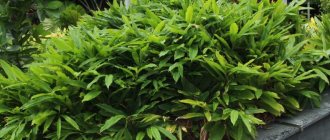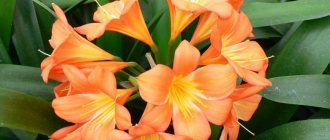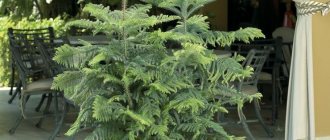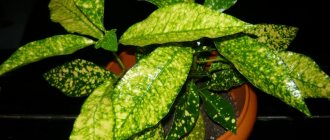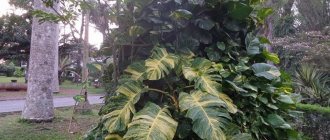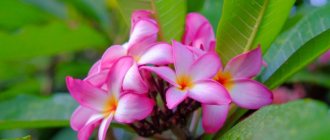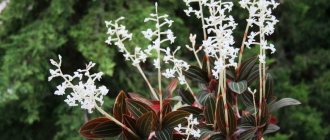Most gardeners know Araucaria under the nickname of indoor spruce. This ancient, relict plant is perhaps the only coniferous crop that can really be grown at home. An elegant giant with a thin trunk, beautiful large branches, inimitable textures, and special soft needles looks impressive. But you have to “pay for” beauty with very careful care. Like all conifers, araucaria loves cool winters, requires a special humidity regime and is intolerant of even small mistakes in care.
Araucaria is an indoor Christmas tree. © The Sill
Description of the plant
Araucarias are most often purchased as an alternative to cut live trees or artificial Christmas trees for the winter holidays. But the plant is much more promising than just an elegant indoor Christmas tree. If you need a giant from the category of evergreen stars, there is a suitable cool place; you cannot find a more spectacular candidate than araucaria.
Araucaria (Araucaria) from the family of the same name Araucariaceae is one of the most ancient coniferous plants on the planet, a forest-forming giant in the highlands of the Andes, common on numerous islands of the southern hemisphere. These are powerful monoecious trees up to 65 m or more in height. In indoor format, the size of araucaria is limited by the height of the ceiling.
Whorled, horizontal, often slightly drooping at the ends, triangular branches seem graceful and strikingly massive. An ideally straight, thin trunk with grayish bark and widely diverging branches in whorls allow Araucaria to form a tiered, structured, transparent, strict cone-shaped crown. The side branches are long, straight, drooping.
Araucarias are captivated by the density of spirally growing needles, which after 30-40 years change shape from long-needle to scaly. Indoor araucarias “have time” to show off only with “young”, long, ribbed, soft awl-shaped needles, curved upward, from 1 cm in length with a width of only 1 mm. A rich dark green shade with a bluish lower edge is characteristic of all araucarias, except for the completely bluish-blue decorative forms of glaucus.
The plant does not bloom in rooms; you can admire the long thin male rafters and hemispheres of female cones only in botanical gardens.
general description
The indoor flower Araucaria is an evergreen tree that in appearance resembles a standard spruce. In open ground the plant can reach great heights. At home, a flower rarely grows more than 1.5 m.
If you engage in crown formation, you can get a neat bonsai. The tree is valued not only for its decorative value. It produces phytoncides that have a beneficial effect on the surrounding air.
Types of indoor araucarias
Of the 19 species of araucaria in indoor format, only one has really taken root - araucaria heterophylla, known throughout the world as Norfolk pine .
Thanks to the experiments of Dutch breeders, other varieties with a height of 2 to 4 meters occasionally appear on sale:
- Araucaria angustifolia, or Brazilian candelabra tree (Araucaria angustifolia), characterized by horizontal branches with unusual whorls at the ends and rapid falling of the lower branches, due to which the crown takes on an umbrella shape;
- Hanstein's araucaria (Araucaria hunsteinii) with denser tiers of branches and horizontally spaced lateral branches.
Variegated araucaria (Araucaria heterophylla). © dscloudtechnology Araucaria angustifolia. © cycadales
Araucaria hunsteinii. © conifersociety
Growing conditions for indoor araucaria
Araucaria is only slightly better adapted to relatively warm wintering than other conifers. A place in a cool winter garden or greenhouse is also more suitable for it than in a room.
Lighting and placement
Indoor Araucaria spruce is afraid of direct midday sun only at the height of summer. The brighter the lighting, the less the plant stretches, the denser the whorls grow, the longer and more magnificent the drooping side branches. Any lack of light causes irreversible damage to the needles and loss of lower branches. The ideal place for araucaria during the active growing season is considered to be eastern and western windows. In winter, plants need to be illuminated up to twelve hours of daylight or moved to a southern windowsill.
For normal development of the plant, it is necessary to regularly turn the pot. When using artificial lighting, you need to take into account that the only option for placing lamps is on top of it+.
Even for young araucarias, it is always worth remembering the scope of the foliage. The branches should not rest against walls or other surfaces; the plant needs space and free air circulation. This plant is intended for decorating only large rooms.
Caring for araucaria at home
Watering and timely increase in air humidity are the key to success with araucarias. The plant often unpleasantly surprises even experienced gardeners.
Watering and air humidity
Araucaria should be protected from any “water” stress, avoiding dampness or drying out of the soil. It is better to regulate watering by allowing the substrate to dry thoroughly in the top layer, up to 4 cm, and immediately draining the water released into the trays. In winter, the soil is dried a few centimeters deeper, reducing the amount of water when watering.
Araucaria is watered only with lukewarm (3-5 degrees higher than the air in the room) and soft water.
The higher the air humidity, the easier it is for araucaria to adapt to room conditions. If these indicators drop below 50%, araucaria cannot tolerate proximity to batteries, immediately reacting with drying out and yellowing of the needles, especially at the ends of the branches. Frequent misting is the best method to compensate for heat and dry air. But you can only spray the crown at temperatures above 18 degrees, and not everyone can afford to spray it up to 3-5 times a day, so it is better to stabilize the conditions using a humidifier or trays with wet pebbles, moss, and expanded clay.
Araucaria does not tolerate dust. If you do not spray and wash the plant regularly, the needles will fall off.
Top dressing and fertilizer composition
Only special fertilizers for coniferous plants are suitable. Araucarias do not tolerate phosphorus. Fertilizers are applied exclusively during the period of active growth, in liquid form, dissolved in water for irrigation, in a standard dosage, every 2 weeks (or according to the manufacturer’s instructions).
For araucaria, it is better to choose a special substrate for conifers. © Rakutenuchg
Pruning and replanting araucaria
The plant does not tolerate cutting off the top, completely stopping vertical growth. You can keep araucaria “in shape” only with proper care.
This plant can only be transferred, without replacing the soil and without washing it off or shaking it off from the roots to preserve mycorrhiza. Exposing the roots is destructive. Change containers as needed - when the earthen ball is completely entwined with roots. The norm is 1 transplant every 3-4 years.
With the help of tight containers, the growth of the plant and its height are restrained. Araucarias do not tolerate excess space; it is better to limit the pots to medium sizes; when the maximum is reached, simply cut off the root ball (no more than half). You need shallow, fairly flat pots, with increments of 2-3 cm in size.
For the plant, it is better to choose a special substrate for conifers or a combination of turf, leaf soil, coniferous soil, humus and sand (2:1:1). The addition of bark and pine litter will not be superfluous even for ready-made substrates. A neutral reaction is acceptable, but slightly acidic and acidic soil mixtures with a pH of 3.0 to 5.5 are preferred.
“An indoor Christmas tree in a pot is a very profitable investment! It looks beautiful, is not expensive, lives long, and grows slowly. I bought it once and provided my New Year holidays with a real live tree for many years” - that’s exactly what one of my friends thought and last New Year he gave me a Canadian spruce, the Konik variety. How to make Christmas tree decorations with your own hands.
Indeed, on New Year's Eve, garden and shopping centers, flower shops and supermarkets offer various options for live Christmas trees in pots, both with and without New Year's decorations. And after the holidays, unfortunately, most of these specimens end up in the trash with dry soil, yellowed and crumbling needles.
In fact, a Christmas tree can easily be grown at home if you provide it with suitable living conditions and regular care.
General information
Konika - a variety of Canadian spruce or gray spruce - is an evergreen coniferous tree of the pine family. It came to us from North America and is currently cultivated as an ornamental plant. It is successfully grown in marine, continental and temperate climates. A fairly drought-resistant plant and not picky about the soil. Not afraid of winds. It has high winter hardiness: it can withstand short-term temperature drops to -30 °C, but the optimal maintenance temperature is from +18 to -5 °C. It grows very slowly, at the age of ten it reaches a height of about 1 m. The young needles are light green in color and darken over time. The length of the needles is 10-15 mm. The buds are small and brown in color.
The plant is very light-loving. South windows are suitable for it, but it also feels good on the west or east side. When there is enough light, the needles grow thick and lush. If there is insufficient lighting, the gaps between the needles increase, and the branches and trunk look elongated.
Caring for the Christmas tree during the New Year holidays.
So, you have a live Christmas tree in a flower pot in your apartment. Place it on the brightest windowsill. If this is not possible, provide additional lighting for 8-9 hours a day. A table lamp will do just fine.
Spruce does not like drying out or waterlogging of the soil. Watering the plant should be regular but moderate. It is better to water the tree with settled water at room temperature, when the surface of the soil has already dried by 2-3 cm, but has not dried out and has not begun to crack.
You can determine the frequency of watering experimentally using a wooden stick, lowering it a couple of cm into the soil and leaving it there for an hour. If, after pulling out the stick, its tip is wet, it is too early to water the plant. I water the conic once every 3-4 days, depending on changes in air humidity, which is affected by sunny or rainy weather outside. Your watering schedule may differ from mine by 1-2 days.
Water is poured into the pot slowly, in a circle, until it begins to seep into the drainage holes at the bottom of the pot. After about 15 minutes, when all the excess water has drained into the pan, it needs to be drained. The Christmas tree does not tolerate soaking of the roots, which can begin to rot due to excess moisture.
In winter, the air in enclosed spaces becomes dry due to the central heating system or various heating devices. Moreover, the higher the air temperature, the drier it is. Too hot and dry air in the apartment can cause conic needles to dry out and fall off. To eliminate this problem, it is enough to spray the plant 1-2 times a day with settled water at room temperature.
By the way, spraying achieves not only moistening, but also cooling of the needles. When a liquid evaporates from a surface, its temperature decreases due to the fact that molecules with greater kinetic energy leave it. The liquid molecules remaining on the surface have less kinetic energy, move less, their temperature is lower, and therefore they cool the surface on which they are located. I will no longer burden you with physical and chemical processes. Just remember how cool you felt after swimming in a river, lake, pond or sea on a hot summer day. The Christmas tree feels about the same after spraying. Also, with frequent spraying, the time between watering increases, thus you can save some water.
When the holiday season is over, carefully remove all holiday decor from the tree. If the branches have been sprayed with artificial snow or glitter, it must be washed off! Cover the surface of the pot tightly with a plastic bag or stretch film to prevent excess water from getting into the soil, and rinse the needles thoroughly in the shower, placing the plant in a horizontal position.
Konica is an actively breathing plant; it requires a lot of fresh air. Even regular airing of the room will not help. So forget about the phrase “indoor Christmas tree.” The only place in the apartment where the Christmas tree will survive is a loggia or balcony, preferably not glazed; in extreme cases, glazed, but not insulated and constantly ventilated.
Wintering the Christmas tree
Like any plant, spruce has a growth phase and a dormant phase. When a plant rests, most of its physiological processes are suspended, while some processes stop completely. The plant’s body practically does not function; it gains strength for further growth.
The resting phase occurs during the winter period. But in order for the tree to “fall asleep”, it needs sub-zero temperatures. This is another reason why she should live on the balcony and not in the room.
Despite the fact that coniferous trees are frost-resistant plants, a Christmas tree in a flower pot in winter runs the risk of complete freezing of the earthen clod, when at sub-zero temperatures the soil moisture turns into ice and the soil itself hardens. This can lead to freezing of the roots. If, when the temperature drops, the needles themselves prepare for winter, then the root system of the conic needs to be additionally prepared - covered.
There are many different ways to cover plants for the winter. I use one of the simplest ones. At the bottom of a flower pot with a slightly larger diameter than the pot in which the conic is planted, I add tree bark, perlite or vermiculite. If there are drainage holes in the pot, they need to be covered so that the insulation does not spill out. I place the plant in the pot and completely cover it with insulation. With the onset of spring, when the night temperature rises to above zero, the tree can be removed from a large pot.
In winter, the number of irrigations and the volume of water used for irrigation are significantly reduced. In my conditions, watering is carried out no more than once a week, I just lightly moisten the surface of the soil, and when it’s frosty, I don’t water the plant at all. And no spraying. From the beginning of spring until late autumn, when the plant is actively growing, the frequency of watering increases, and when the air temperature is above 18 °C, we resume regular spraying of the needles.
From the beginning of February, when the sunlight becomes brighter, the process of photosynthesis begins in the needles, which is accompanied by a large consumption of moisture. At the same time, the root system is still dormant and is not able to absorb moisture from the soil. As a result, the needles dry out, turn yellow and crumble, and the plant itself may die.
This phenomenon is called a sunburn. To avoid it, from the beginning of February to mid-March, the tree must be hidden from direct sunlight. Just move it deeper into the balcony, and from mid-March begin to gradually accustom it to bright light, daily increasing the time it is exposed to sunlight.
However, if you still get a burn, but no more than 40% of the crown is damaged, the tree can still be revived with growth stimulants, for example, Epin-Extra or Zircon, diluting them with water according to the instructions indicated on the package, and spraying the crown 2-3 times with an interval of 5-7 days.
Christmas tree fertilizers
From spring to autumn, it is advisable to feed the conic with fertilizers, then it will grow actively, will not get sick and will not be attacked by pests. A lot of fertilizers for conifers are now sold. Manufacturers include additional elements in their composition, supposedly for: balanced nutrition, preventing the loss of greenery, increasing resistance to adverse conditions, and so on. Sometimes you can read something on the packaging that makes you want to take these fertilizers instead of vitamins. In general, I think it’s all marketing. The main thing is that the fertilizer contains: nitrogen, phosphorus and potassium.
Shake the bottle well before using liquid fertilizer. Next, dilute the fertilizer with water in the proportions indicated on the package. First, lightly moisten the earthen ball with clean, settled water, and only then water the plant with a fertilizer solution. You can spray the needles with the remains of the diluted fertilizer, but it is not recommended to store the remains for later use, so if you need to fertilize just 1 tree, it is better to use a pipette instead of a measuring cap. The frequency of fertilizing mainly depends on the fertilizer used, as the manufacturer indicates on the packaging. As a rule, they fertilize the Christmas tree at least 2 times per season, maximum – once every 2 months, and it’s not worth it more often.
Christmas tree transplant
Coniferous plants in a flower pot, although slowly, grow, their roots grow into drainage holes, and the soil is depleted. Therefore, they periodically need a transplant. The tree can be replanted in early spring, before young needles appear, or in autumn, before the first frost.
The root system of spruce does not penetrate deep into the soil; its taproot practically stops growing vertically at the age of 2-3 years. At the same time, the tree’s lateral roots grow and branch horizontally. It is better to choose a pot for replanting that is not deep, 1-2 cm in diameter wider than the previous pot and must have drainage holes. To prevent stagnation of excess water, you need to additionally place a drainage layer on the bottom of the pot; a couple of centimeters of expanded clay will do.
The soil for the Christmas tree should have an acid index of 4-5 and allow moisture and air to pass through well. The soil composition should include high-moor peat, turf soil, river sand, perlite or vermiculite. I don’t bother with mixing different components, I just buy ready-made soil for conifers and additionally add perlite or vermiculite to it, since peat tends to dry out a lot, which does not have a very beneficial effect on the conic.
The roots of spruce lack root hairs, with the help of which other plants absorb water, mineral salts and nitrogenous substances. The role of root hairs in this case is played by thin threads of the fungus that entangle the ends of the roots. This phenomenon is called mycorrhiza or fungal root. Scientists believe that mycorrhizae are found in half of the species of European flora: trees, shrubs and herbaceous plants. Mycorrhiza was first described at the end of the 19th century by botanist Franz Mikhailovich Kamensky.
The death of mycorrhiza leads to the fact that the plant is not able to feed on its own and also dies, so it is not necessary to replant the conic often, once every 2-3 years using the transshipment method. A little new soil is poured into a new pot with expanded clay at the bottom. The tree is carefully removed from the old pot, after slightly cleaning the earthen ball along with the old soil, it is moved to a new pot. Fresh soil is added to the sides and top without deepening the plant's growing point.
After transplantation, the plant is watered. During watering, fresh soil settles slightly, so you need to add dry soil. To prevent the top layer of soil from drying out, you can mulch it - add tree bark.
If the plant is transplanted into purchased soil that contains minerals and trace elements, there is no need to fertilize the plant within a month after transplantation.
Crown formation
As a rule, conics naturally have a beautiful shape and do not require any crown shaping. However, if you do not like the appearance of the plant, it can be slightly adjusted.
Usually bonsai masters are engaged in shaping conifers. By the way, they have one important rule: before the formation begins, the plant after purchase must fully adapt to new living conditions. This adaptation lasts a year. That is, you can start forming the crown only when the plant has lived in your house for a year and is not sick.
To change the direction of growth of conic branches, you can apply a ligature to them - wind the wire, having previously secured it on the trunk at the base of the branch and wrap the branch at an angle of 45°, without touching the needles if possible. It is better to apply a ligature to conifers at the end of autumn, when the plant begins to enter the dormant stage. The wire should be soft, preferably made of non-ferrous metal or insulated, so that it does not rust when spraying the plant. The diameter of the wire should be about a third or a quarter of the thickness of the branch.
After winding the wire, the branch easily bends and is fixed in a new position. The plant remains in this state for 3 to 6 months. During this time, the branch gets used to the new position, after which the wire is cut off. While the wire is still on the branch, you need to make sure that it does not start cutting into the bark, especially starting from the end of winter. In this case, you need to cut it off and screw on a new one, a little weaker.
At the end of spring and beginning of summer, when the period of active sap flow ends, the plant requires sanitary pruning - removal of dry and diseased branches.
As the conic grows, it can reach a height of 2.5 meters and no longer fit in the apartment. To avoid this, in addition to sanitary pruning, you can pinch the shoots - trim the ends a couple of centimeters, without touching the needles below the cut. This will make the branches begin to branch better and become more luxuriant. To prevent the plant from suffering too much from pruning, no more than 15% of the crown can be cut off at a time. The tool must be sharp, clean and disinfected. After pruning, the plant can be sprayed.
Christmas tree diseases and pests
Most diseases of coniferous plants are of fungal origin. In the early stages, they are treated with simple treatments with fungicidal preparations.
A coniferous tree that is still weakened is susceptible to attack by insect pests. They can be overcome with the help of insecticidal preparations.
During treatment, it is better to remove the tree away from other plants until complete recovery, and treat it with fungicides and insecticides not only for treatment, but also as a preventive measure - once a year, in early spring.
With proper care, conika can live for more than three hundred years. Maybe one day your descendants, when decorating the New Year tree, will remember you with gratitude!
Diseases, pests and problems in growing
Indoor spruce easily loses its needles, turns yellow, becomes exposed below, becomes deformed and stretches. Damaged needles cannot be restored, so critical mistakes in care should be avoided at all costs.
In a weakened state, when taken out into the garden, araucaria can suffer from any pests of coniferous plants; mealybugs and spider mites are often found indoors. Control measures should be combined with the use of strong systemic insecticides.
You can try to grow indoor spruce from seeds, but they lose their viability extremely quickly
Possible problems
- Do not forget that the top of the spruce tree is its growth point. If you damage the top, the tree will stop growing upward and an ugly crown will begin to develop.
- If you constantly keep the ephedra at too high a temperature, it will begin to droop branches and shed needles.
- Too low humidity in the room can cause the needles and even shoots to dry out. The plant can also become sick due to insufficient watering.
- If the spruce tree does not have enough nutrients, the shoots will begin to thin out and the tree will look weakened.
- Araucaria indoors is a plant that does not like calcium. Due to excess calcium in fertilizing, indoor spruce may stop growing.
Sometimes indoor spruce trees are attacked by pests. Particularly dangerous are aphids and mealybugs, which damage wood. If you find insect pests, the plant should be washed with soapy water or sprayed with an alcohol solution. If there are too many insects, the conifer should be treated with an insecticide.
If araucaria is properly cared for and favorable conditions are created for it, then an indoor spruce can grow into a very decorative and majestic tree, which is good for decorating the interior of large rooms. Growing and caring for araucaria at home is quite simple.
Gallery – araucaria photo.
Araucaria propagation
You can try to grow indoor spruce from seeds, but they lose their viability extremely quickly. Sowing is carried out immediately after their collection, in a sand-peat soil mixture, superficially, under film or glass. Germination will take several months even at a stable temperature of 25 degrees. Slowly developing seedlings require very careful care and are sensitive to any stress.
Cuttings using the tops of branches cut several centimeters below the whorl of lateral branches or re-rooting the tops of spruce trees are very difficult; araucarias take root poorly. Drooping small side branches, broken off at the heel, often develop asymmetrically, so they are used as a last resort.
After treatment in the rooter, the cuttings are buried up to the first whorl in peat tablets or a disinfected light substrate. And they are kept in a greenhouse at a temperature of about 25 degrees for 4 months.
